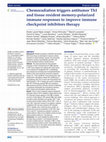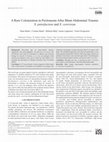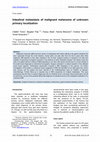Papers by Viorel Scripcariu

Healthcare
The incidence of colon, rectal, and colorectal cancer is very high, and diagnosis is often made i... more The incidence of colon, rectal, and colorectal cancer is very high, and diagnosis is often made in the advanced stages of the disease. In cases where peritoneal carcinomatosis is limited, patients can benefit from newer treatment options if the disease is promptly identified, and they are referred to specialized centers. Therefore, an essential diagnostic benefit would be identifying those factors that could lead to early diagnosis. A retrospective study was performed using patient data gathered from 2010 to 2020. The collected data were represented by routine blood tests subjected to stringent inclusion and exclusion criteria. In order to determine the presence or absence of peritoneal carcinomatosis in colorectal cancer patients, three types of machine learning approaches were applied: a neuro-evolutive methodology based on artificial neural network (ANN), support vector machines (SVM), and random forests (RF), all combined with differential evolution (DE). The optimizer (DE in ou...
J de Chirurgie, 2014
Surgery remains the main treatment for localized resectable esophageal cancer. Open esophagectomy... more Surgery remains the main treatment for localized resectable esophageal cancer. Open esophagectomy is still the standard surgical approach for esophageal cancer but it has a lower patient satisfaction when compared with other treatment options. In the era of "key-hole" surgeries, minimally invasive esophagectomy (MIE) stands as a solution to improve the results after standard open esophagectomies. The aim of the present paper is to provide a short update regarding the minimally invasive esophagectomy, with special emphasis on its indications, results and current controversies.

MULTIDISCIPLINARY MANAGEMENT OF RECTAL CANCER - A R ETROSPECTIVE STUDY - (Abstract): Background: ... more MULTIDISCIPLINARY MANAGEMENT OF RECTAL CANCER - A R ETROSPECTIVE STUDY - (Abstract): Background: The procedure of low or very low anterior resection of the rectum with total mesorectal excision (TME) it is now widely accepted for tumours of the middle and lower third of the r ectum. It has become the gold standard for the treatment of c ancer of the rectum, except where the tumor is clos e to or is involving the anal sphincter complex. Patients and methods: A retrospective study on 120 patients diagnosed with colorectal cancer and operated on between 2000 and 2004 was carried out. There were 120 anterior resection of the rectum, in 34 cases the total meso rectal excision has been performed and in 11 cases a very low anterior resection was made. All 45 cases where tot al mesorectal excision was made, had undertaken preoperative radiotherapy, surgery being performed after 4 to 6 weeks from the last session of radioth erapy. Results : The overall operative morbidity rate was 16.10% i n...

Romanian Journal of Morphology and Embryology, 2020
Introduction: Brain metastases (BMs) originating in colorectal cancer (CRC) have a significant im... more Introduction: Brain metastases (BMs) originating in colorectal cancer (CRC) have a significant importance for patients’ survival. Because in literature there are only isolated case reports and only few series published on this issue, we aimed to assess the incidence of BMs from CRC, to identify patient’s characteristics and BMs clinical, histopathological (HP) and immunohistochemical (IHC) features, and to compare the data we obtained with those from literature. Patients, Materials and Methods: We present a retrospective study of 27 histologically confirmed cases of BMs from CRC among all 1040 patients who received metastasectomy in the Department of Neurosurgery, Prof. Dr. Nicolae Oblu Emergency Clinical Hospital, Iaşi, Romania, in an eight-year period (January 2011 to December 2018). Patients’ characteristics (gender, age), primary tumor location, time from primary tumor surgery to BMs surgery and BMs features (number, location and HP characteristics) were investigated. Histochemi...

Journal for ImmunoTherapy of Cancer
BackgroundMultiple synergistic combination approaches with cancer drugs are developed to overcome... more BackgroundMultiple synergistic combination approaches with cancer drugs are developed to overcome primary resistance to immunotherapy; however, the mechanistic rationale to combine chemoradiotherapy (CRT) with immune checkpoint inhibitors remains elusive.MethodsThis study described the immunological landscape of tumor microenvironment (TME) exposed to CRT. Tumor samples from patients with rectal cancer (n=43) treated with neoadjuvant CRT or radiotherapy were analyzed by nanostring and immunohistochemistry. Studies in mice were performed using three syngeneic tumors (TC1, CT26 and MC38). Tumor-bearing mice were treated either with platinum-based CRT, radiotherapy or chemotherapy. Anti-CTLA-4 and/or anti-Programmed Cell Death Receptor-1 (PD-1) therapy was used in combination with CRT. The therapy-exposed TME was screened by RNA sequencing and flow cytometry and tumor-infiltrating T lymphocyte functionality was evaluated by interferon (IFN)-γ ELIspot and intracellular cytokine staining...

Background and Aim: In metastatic colorectal cancer, in the last 10 years, hepatic arterial infus... more Background and Aim: In metastatic colorectal cancer, in the last 10 years, hepatic arterial infusion (HAI) was proposed as an alternative using various chemotherapy agents. The insertion of a port-a-cath in the hepatic artery is needed and there are various methods to do that, from classical to interventional approach. Patients and Methods: Patients were selected with metastatic colorectal cancer with inoperable liver metastasis only and were treated with oxaliplatin HAI, combined with systemic intravenously chemotherapy. The port-a-cath insertion was done using the classical approach in the same surgical time with the subclavicular vein port insertion. Results: Thirty-two patients were treated. During our experience we did not encounter intra-operative complications. Among the immediate post-operative complications mainly consisted of metabolic complications (6.2%) and infection was the most common late complication (9.4%). In one case we removed the port-a-cath, thus the patient w...

J de Chirurgie, 2014
Background: The main surgeries that can be performed in upper and mid rectal cancer are low anter... more Background: The main surgeries that can be performed in upper and mid rectal cancer are low anterior rectal resection (LAR), lateral colostomy (LC), and extended Hartmann operation with mesorectal excision (EHO). Compared to lateral colostomy, EHO is a curative surgery; it also takes a shorter time to perform and has a lower mortality compared with LAR. Objective: The aim of this study was to analyze the postoperative surgical complications in patients who underwent LAR, LC, or EHO. Methods: The study is a prospective analysis based on a Surveillance protocol for patients with liver metastases of colorectal origin used in First Surgical Oncology Unit, Regional Institute of Oncology IaAŸi, Romania. The postoperative complications occurring within 60 days postoperatively were analyzed. Results: In the interval June 2012 – May 2014, 87 patients were diagnosed with upper and mid-rectal cancer and liver metastases; LAR was performed in 18 patients, LC in 19 patients and in 50 patients EHO with pelvic drainage abdominally exteriorized or perineally (37 and 13 patients, respectively). The postoperative complications related to surgical wound, stoma, pelvic abscess, postoperative bleeding, prolonged postoperative ileus, anastomotic leakage, reinterventions, readmissions, and mortality were analyzed. A higher rate of pelvic abscesses was found in EHO patients (24%, n=12), of which 9 patients (18%) required reinterventions for drainnage of pelvic fluid collection; all these patients had pelvic drainage exteriorized abdominally. No presacral abscesses were recorded in patients with pelvic drainage exteriorized perineally. Conclusions: Extended Hartmann Operation (EHO) remains a safe technique, that shares some indications with LAR and LC; however, it is associated with a higher percentage of pelvic abscesses and reinterventions that can be avoided by postoperative perineal drainage of the presacral space

Balkan Medical Journal
Background: Shewanella spp. are gram-negative bacteria, saprophytes, and rarely pathogenic. Sacch... more Background: Shewanella spp. are gram-negative bacteria, saprophytes, and rarely pathogenic. Saccharomyces cerevisiae is the well-known yeast used for fermentation in industry and molecular biology for research. In humans, it is a very rare pathogen which colonizes the digestive tract, and its utility has been linked to the treatment and prevention of diarrhea associated with Clostridium difficile. Case Report: A 27-year-old male, victim of aggressive, blunt trauma with a 4-day history of symptoms was admitted to our surgery unit. Abdominal sonography revealed peritoneal fluid in all spaces with fibrin. We performed laparotomy and observed perforations on the ileum and general peritonitis with pus. Following surgery, patient was admitted to the intensive care unit with septic shock. The antibiogram from the peritoneal liquid revealed S. putrefaciens and S. cerevisiae. Conclusion: Although very rare, S. putrefaciens and S. cerevisiae may colonize in the peritoneum after blunt abdominal trauma.

Journal for ImmunoTherapy of Cancer
BackgroundNew and fully validated tests need to be brought into clinical practice to improve the ... more BackgroundNew and fully validated tests need to be brought into clinical practice to improve the estimation of recurrence risk in patients with colon cancer. The aim of this study was to assess the analytical performances of the Immunoscore (IS) and show its contribution to prognosis prediction.MethodsImmunohistochemical staining of CD3+ and CD8+ T cells on adjacent sections of colon cancer tissues were quantified in the core of the tumor and its invasive margin with dedicated IS modules integrated into digital pathology software. Staining intensity across samples collected between 1989 and 2016 (n=595) was measured. The accuracy of the IS workflow was established by comparing optical and automatic counts. Analytical precision of the IS was evaluated within individual tumor block on distant sections and between eligible blocks. The IS interlaboratory reproducibility (n=100) and overall assay precision were assessed (n=3). Contribution of the IS to prediction of recurrence based on c...

Chirurgia
Introducere: Anemia şi transfuzia reprezintă factori de risc independenţi de evoluţie nefavorabil... more Introducere: Anemia şi transfuzia reprezintă factori de risc independenţi de evoluţie nefavorabilă în cancerul colorectal. Anemia severă poate creşte agresivitatea tumorală iar transfuzia poate induce imunosupresie, promovând astfel recurenţa cancerului. Strategiile de Gestionare a Sângelui Pacientului (GSP), specifice pentru pacienţii oncologici, sunt în prezent insuficient definite şi recomandate. Obiectiv primar: Evaluarea prevalenţei anemiei şi a ratei de transfuzie perioperator la pacienţii cu neoplasm colorectal. Obiectiv secundar: Analiză subgrup pacienţi anemici versus non-anemici, cancer de colon versus cancer rectal. Metodă: Am evaluat retrospectiv datele pacienţilor oncologici chirurgicali consecutivi admişi în intervalul Ianuarie-Iunie 2017. Am selectat pacienţii cu chirurgie abdominală inferioară şi ulterior chirurgie colo-rectală. Au fost înregistrate dinamica perioperatorie a valorilor hemoglobinei (preoperator = Hb1, postoperator = Hb2, la externare = Hb3), prevalenţa şi severitatea anemiei, rata de transfuzie. Analiza statistică a utilizat testele t Student, Wilcoxon şi Chi-pătrat din programul SPSS 17.0. Rezultate: Din 1284 pacienţi evaluaţi, 546 au fost supuşi chirurgiei abdominale inferioare şi 260 chirurgiei colorectale. Vârsta medie a fost de 65.6 ± 11.1 ani, 57.7% gen masculin. Dinamica perioperatorie a hemoglobinei a fost Hb1/Hb2/Hb3=12/

Chirurgia
Introducere: În acest studiu, ne propunem să identificăm efectul radioterapiei neoadjuvante asupr... more Introducere: În acest studiu, ne propunem să identificăm efectul radioterapiei neoadjuvante asupra numărului de ganglioni limfatici totali recoltaţi şi pozitivi în piesa operatorie. În plus, am încercat să identificăm impactul chimioterapiei asociate cu radioterapia asupra structurilor menţionate. Pacienţi şi metodă: În cadrul studiului am inclus pacienţi trataţi pentru cancer rectal într-o singură unitate chirurgicală oncologică care deserveşte partea nord-estică a României, pe o perioadă de 5 ani şi jumătate, între mai 2013 şi aprilie 2018. În primul rând, am comparat stadializarea anatomopatologică a ganglionilor limfatici cu stadializarea preterapeutică. În al doilea rând, am comparat valorile ganglionilor limfatici în raport cu schema de tratament. Rezultate: În total, 498 de pacienţi au fost trataţi radical prin intervenţii chirurgicale deschise pentru cancer rectal mediu şi inferior. Am observat o scădere a stadializării N în 218 cazuri, 65 rămânând staţionare şi în 10 crescând stadiul ganglionar pe specimenul chirurgical. Am identificat diferenţe semnificative în numărul total de ganglioni (17.4 vs 24,2, p<0.001), numărul de ganglioni pozitivi (1.4 vs 3.4, p<0.001) şi raportul între numărul de

Chirurgia
Colorectal cancer is a major health issue all over the world and, during the last century hass se... more Colorectal cancer is a major health issue all over the world and, during the last century hass seen great improvements in colorectal cancer management. The interest for rectal pathology has been established even from Hippocrates' era (1,2). In the 19 th century, the management of rectal cancer was based on a colostomy, first time described in 1776 by Jean Zulema Amussat. In 1826 Jacques Lisfranc successfully performed the first resection for rectal cancer, removing only a few centimeters of the distal rectum, procedure published in 1833 (3). In 1908 in Lancet, Sir Ernest Miles published a new method of performing abdomino-perineal excision for carcinoma of the rectum and the terminal segment of the pelvic colon, considered "one of the most formidable operations in surgery" with a mortality of 41.6% (4). Too much conservatism in the removal of the organ associated with a high rate of local recurrence were the arguments for a new technique (5). In 1917 Arthur D. Bevan published a paper which described the posterior approach to the rectum by complete division of the anal sphincters in the midline and coccygectomy, technique that later was recognized as Bevan procedure (6). William Bashall Gabriel (1893-1975) proposed a 1-stage procedure called "perineo-abdominal excision of the rectum" and in 1934 Martin Kirschner first imagined a technique that allowed two surgical teams to work at the same time. A combined lithotomy-Trendelenburg position enabled Lloyd-Davies in 1939 to perform the first synchronous combined radical abdominoperineal resection using adjustable leg support (3). In 1930 Dukes describes the possible dissemination pathways for cancer of the rectum and a new classification of
Chirurgia
Institutional resources Assumed operational strategy (relative to the treatment of COVID-19 patie... more Institutional resources Assumed operational strategy (relative to the treatment of COVID-19 patients) (Human and material) Low There are enough resources Elective procedures for colorectal oncological surgery. Patients should be treated in non-COVID-19 hospitals / departments. Surgery for benign conditions should be postponed until the peak of the pandemic has been exceeded Moderate The hospital's resources are limited All surgical cases and elective endoscopic procedures should be postponed High Critical unavailability of hospital Surgery should be limited to those patients with life-threatening resources conditions (eg. gastrointestinal bleeding, perforation or obstruction), advanced symptomatic tumors, urgent anorectal, etc.

Diagnostics
Left atrial structural, functional and electrical remodelling are linked to atrial fibrillation (... more Left atrial structural, functional and electrical remodelling are linked to atrial fibrillation (AF) pathophysiology and mirror the phrase “AF begets AF”. A structurally remodelled left atrium (LA) is fibrotic, dysfunctional and enlarged. Fibrosis is the hallmark of LA structural remodelling and is associated with increased risk of stroke, heart failure development and/or progression and poorer catheter ablation outcomes with increased recurrence rates. Moreover, increased atrial fibrosis has been associated with higher rates of stroke even in sinus-rhythm individuals. As such, properly assessing the fibrotic atrial cardiomyopathy in AF patients becomes necessary. In this respect, late-gadolinium enhancement cardiac magnetic resonance (LGE-CMR) imaging is the gold standard in imaging myocardial fibrosis. LA structural remodelling extension offers both diagnostic and prognostic information and influences therapeutic choices. LGE-CMR scans can be used before the procedure to better se...

Archive of Clinical Cases
Malignant melanoma (MM) has been shown to metastasize with relative affinity to the gastro-intest... more Malignant melanoma (MM) has been shown to metastasize with relative affinity to the gastro-intestinal (GI) tract, especially through the small intestine, mostly within, but also later than the first 5 years after initial diagnosis. MM appears to less often originate in the GI tract. Surgical excision is reported to be safe and capable of improving oncological outcomes in the absence of other metastatic disease. We hereby report the case of a patient without a history of MM presenting in our clinic with severe anemia due to a tumor located in the small bowel diagnosed on abdominal tomography. Surgery consisted in a radical resection of the affected small bowel segment. Pathological examination revealed a MM metastasis to the jejunum. On further investigation of the patient, a cutaneous lesion suggestive of MM was identified on his right upper limb, which was excised, and the patient has been referred to the multidisciplinary team for initiation of adjuvant chemotherapy. Further follow-up is required due to MM's propensity for multiple metastases. This case emphasizes the fact that in a patient diagnosed with an intestinal tumor a thorough clinical examination should be performed, as one of the possible differential diagnosis of intestinal tumors is the metastatic localization of a cutaneous MM.

Uploads
Papers by Viorel Scripcariu